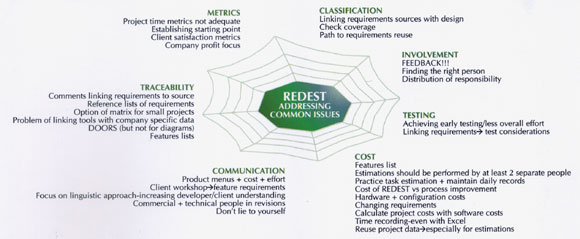
This issue in pdf Archive: |
|
|||
REDEST - Sharing Experiences in the Field of Embedded Software Requirement Gatheringby János Nacsa Requirement gathering is an initial but critical phase of any software development. In embedded systems it is even more difficult, since many of the requirements have effects that cannot be fulfilled with software elements. The aim of the REDEST project is to improve the requirement-gathering phase of the embedded software development process by introducing methodologies to help companies augment the quality of their embedded software. The REDEST consortium consists of fourteen small and medium enterprises (SMEs) from Spain, Germany and Hungary that develop embedded software for their products, three coordinating institutions, and a technology expert company, to harmonise the different activities and provide the SMEs with continuous support.
The SME partners in REDEST perform experimental tasks consisting of two parts: a baseline project on a development common to the given company, and - in conjunction with this - an innovative experiment in RG, with clear objectives and measurement facilities. Each experiment has its own independent strategic, business and technical objectives.
The coordinating/expert partners supervise the experiments and provide the local partners with advice. They also evaluate the results and elaborate the Best Practice cases for identifying and exploiting synergies within the experimental results. The independent method produced by each experiment is then used to measure the resulting business and technical benefits, as explained in their descriptions.
It is expected that a clear connection will be identified between the previous problems and the actions proposed. The Hungarian Experiment The first Hungarian SME is a research and development company. They have high-tech products in the field of medicine, which use embedded software technology. Because of the nature of the company, the requirement specification is not formal and they have no adequate solution for handling changes in the requirements. In the frame of REDEST, they work on the formalisation of their whole development cycle, from the requirement gathering to the final tests. The second Hungarian SME has a relatively large market share in a special field of traffic control. As their products are mainly hardware-oriented, they employ only a few software specialists and thus depend greatly on the expertise of these people. In the future they intend to introduce a more standardised way of working, including requirements gathering, design and tests. They have problems with tracing the effects of the different requirements on the product life cycle, including the software version control during maintenance. The third Hungarian SME produces special high-capacity, high-cost visualisation equipment in relatively small quantities. As they have very remote and culturally different markets, the RG must include communication with their agents, which needs to be more formal and precise. Requirement forms in this case means the ability to select a given product feature from among various options. Examining the different problems of the SMEs in REDEST, the following conclusions were arrived at:
REDEST is designed to be a growing modular structure, to which other sets of local supporting organisations and experiments, or even independent experiments, may be added. The project is sponsored by EC, under the contract no. IST 2000-29425. Link: Please contact: |
|||


